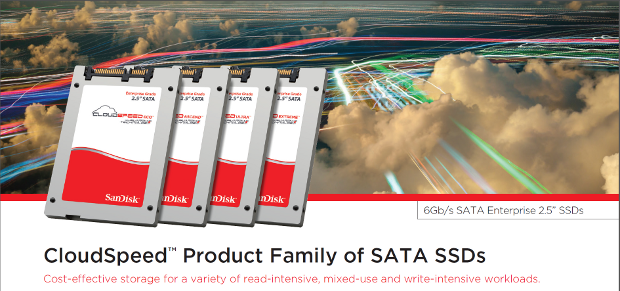SanDisk Corp., a global leader in flash storage solutions, is announcing its new CloudSpeedTM family of SSDs geared to enterprise/datacenter usage. With the continuing explosion of big data and cloud-based storage, SanDisk is positioning itself to take full advantage by offering four new models, each geared to different enterprise usage scenarios.
Cloud-based storage is growing exponentially — just look at these current numbers: 182 billion e-mails sent each and every day (worldwide) and 350 million photos uploaded to Facebook every day. It is predicted that by 2020, I.T. departments will require 10X more servers that are in use today — that’s 1000% growth of an already very large number!
This huge growth rate presents significant challenges for I.T. managers as they develop and configure tomorrow’s datacenters. The “cloud” is all about shared storage, and this requires not just server-level agility, but also storage-tier agility. In-memory computing will require large scale memory pools, and traditional spinning hard drives will struggle to satisfy this demand, not only for performance, but also reliability and longevity.
Traditional comparison of HDDs to SSDs has always focused on cost per GB ($/GB). Configuring tomorrow’s datacenter requires a slightly different perspective, with much more focus on $/IOPS and/or $/watt, rather than just $/GB. Significant reductions in power requirements alone make a mere $/GB comparison increasingly irrelevant. All of these factors are used to determine “total cost of ownership” (TCO). This is the metric that will increasingly drive I.T. managers’ storage selection decisions.
The “flash-transformed” datacenter, utilizing SSDs, will dramatically improve both performance and economics. On the performance side, SSDs facilitate instant data access, reduced latency, faster results, and a superior end-user experience. To satisfy the cost vs. benefit analysis, flash storage usage results in reduced support costs, lowers power and cooling costs, reduces rack and floor space requirements, and accomplishes more with fewer servers and storage arrays.
SanDisk’s CloudSpeed SATA SSD family offers four separate models, each geared to separate datacenter demand scenarios:
CloudSpeed Extreme — For write-intensive applications, the CloudSpeed Extreme is designed with high endurance to satisfy demanding throughput and write requirements, and is rated for up to 10 full drive writes per day. The CloudSpeed Extreme can significantly lower a datacenter’s TCO. Usage scenarios such as the massive databases required for transaction processing would be ideal for the CloudSpeed Extreme.
CloudSpeed Ultra — For mixed-use workloads, the CloudSpeed Ultra offers consistent and predictable performance, and is rated for up to 3 full drive writes per day. E-mail servers are an ideal fit for the CloudSpeed Ultra, with read demands slightly exceeding write demands.
CloudSpeed Ascend — For read-intensive usage, the CloudSpeed Ascend offers reliability to the tune of one full drive write per day. Storage of web content that sees approximately 90% reads vs. 10% writes is a prime usage case for the CloudSpeed Ascend.
CloudSpeed Eco — Also for read-intensive usage, the CloudSpeed Eco offers a more economical version of the Cloud Speed Ascend for cost-effective performance in maintaining a highly consistent quality of service (QoS), and is rated for one full drive write per day.
All of the SanDisk CloudSpeed family of SSDs carry a five-year warranty, except the CloudSpeed Eco, with a lower level of overprovisioning and a three-year warranty. The CloudSpeed family of SSDs feature a SATA 6 GB/s interface, and are constructed with SanDisk’s latest 19nm MLC NAND. One advantage to the 19nm NAND is higher yield — more usable chips per wafer, and more storage capacity in the same footprint.
All models of the CloudSpeed family of SSDs are rated for sequential read speeds of 450 MB/s and sequential write speeds of 400 MB/s. Random 4K reads for all models comes in at 75,000 IOPS, with the Extreme and Ultra having random 4K write speeds of 25,000 IOPS. The Ascend and Eco are rated for random 4K write speeds of 14,000 IOPS and 15,000 IOPS, respectively.
Both the CloudSpeed Eco and CloudSpeed Ascend will be offered in capacities ranging from 240GB to 960GB. The CloudSpeed Ultra will be offered in 200GB to 800GB capacities, and the CloudSpeed Extreme will feature models with capacities as low as 100GB and as high as 960GB.
All models of the CloudSpeed family of SSDs will include SanDisk’s proprietary Guardian Technology platform to enhance flash endurance, ensure data integrity, and ensure against data loss in the event of an unanticipated power failure or interruption. Flash endurance is enhanced by utilizing aggregated flash management, intelligent flash mixing, and adaptive signal processing.
SanDisk in recent years has acquired both Pliant Technologies and Smart Storage Systems to give it a presence in the enterprise storage market. Their timing is proving to be remarkable, as bringing the CloudSpeed family of SSDs to market is occurring at a point in time that will give them an instant outlet for much of the initial production. With companies like Facebook deciding to build an all-flash storage datacenter, combined with the general boom in demand for cloud storage, SanDisk is hitting the ground running with the CloudSpeed enterprise SSD offerings. Availability is expected for mid Q2, with channel availability anticipated for later in Q2 of 2014.
 The SSD Review The Worlds Dedicated SSD Education and Review Resource |
The SSD Review The Worlds Dedicated SSD Education and Review Resource | 

